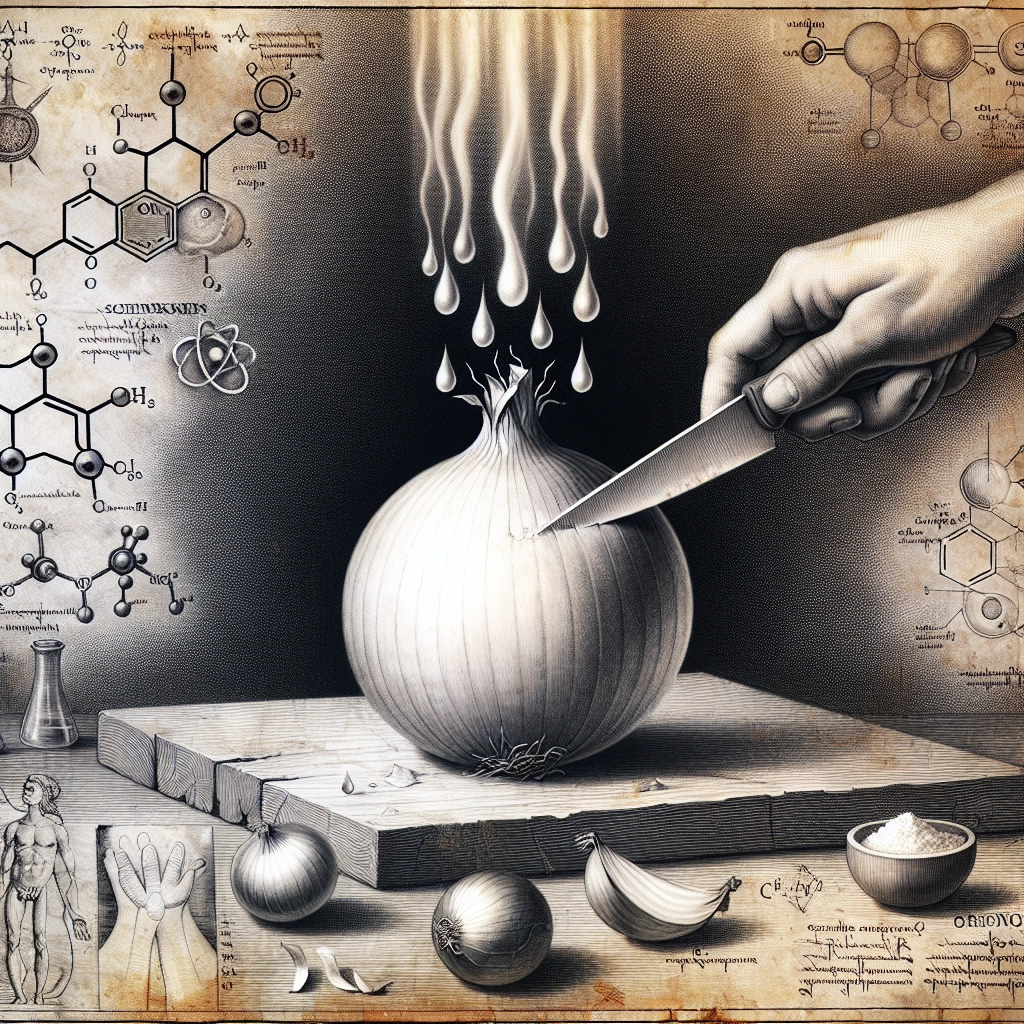
- Published on
- Authors

- Name
- ric de yuga 😄
😢 The Onion Effect: A Culinary Conundrum 😢
Picture this: you're in the kitchen, eagerly preparing a delicious meal that calls for chopped onions. You grab your knife, start slicing, and suddenly your eyes begin to sting and water. Before you know it, tears are streaming down your face, and you're left wondering, "Why do onions have to be so cruel?" If this scenario sounds familiar, you're not alone. The onion's ability to make us cry is a culinary conundrum that has puzzled home cooks and professional chefs alike. But fear not! In this blog post, well unravel the science behind this tearful phenomenon and explore the fascinating chemistry that turns meal prep into an emotional rollercoaster.
🧅 The Anatomy of an Onion: A Layered Mystery 🧅
To understand why onions make us cry, we first need to take a closer look at the structure and composition of these pungent bulbs. Onions are members of the Allium family, which also includes garlic, leeks, and chives. These vegetables are known for their distinctive flavor and aroma, which can be attributed to a group of volatile sulfur compounds.
Onions are composed of several layers, each made up of cells that contain a variety of enzymes and sulfur-containing molecules. When an onion is whole and undamaged, these compounds remain separated within the cells. However, when you slice into an onion, you break the cell walls and set off a chain reaction that leads to the formation of a tear-inducing chemical.
🔬 The Chemistry of Tears: Sulfenic Acids and Syn-Propanethial-S-Oxide 🔬
The primary culprit behind onion-induced tears is a volatile compound called syn-propanethial-S-oxide, also known as the lachrymatory factor (LF). This chemical is not present in intact onions but is formed when certain enzymes and sulfur compounds mix together upon cell damage.
Here's how it works:
When you cut into an onion, you break the cell walls and release an enzyme called alliinase.
Alliinase reacts with sulfur-containing molecules called sulfoxides, which are also released from the broken cells.
This reaction produces sulfenic acids, unstable compounds that rapidly rearrange to form syn-propanethial-S-oxide (LF).
The LF vapor diffuses into the air and eventually reaches your eyes, where it reacts with the water in your tear ducts to form sulfuric acid.
Your eyes, sensing the irritation caused by the sulfuric acid, begin to produce tears to flush out the irritant and protect the delicate surface of your eyes.
It's this involuntary tear response that leads to the watery eyes and runny nose that often accompany onion chopping.
😎 The Quest for Tearless Onions: Culinary Innovations 😎
While the tear-inducing nature of onions may seem like an unavoidable part of cooking, scientists and food innovators have been working to develop solutions that could make tearless meal prep a reality.
Some notable attempts include:
Low-LF Onions: Through selective breeding and genetic modification, researchers have developed onion varieties that produce significantly less LF, minimizing the tear effect.
Pre-Soaked Onions: Soaking onions in water before cutting can help to dilute and wash away some of the enzymes responsible for LF production.
Protective Eyewear: From simple goggles to high-tech "onion goggles," various forms of protective eyewear have been designed to create a barrier between your eyes and the LF vapor.
Cutting Techniques: Some chefs swear by certain cutting techniques, such as chilling the onions before chopping or slicing them underwater, to reduce the amount of LF released into the air.
While these methods can help to minimize the tearful impact of onion chopping, the quest for a truly tearless onion continues to inspire culinary innovators around the world.
😭 Embracing the Tears: A Testament to Flavor 😭
Despite the tears they may cause, onions remain an essential ingredient in countless dishes across the globe. Their unique flavor profile, which includes a complex mix of sweetness, sharpness, and umami notes, adds depth and character to everything from soups and stews to sauces and salads.
In many ways, the tears we shed while chopping onions can be seen as a testament to their flavor-enhancing powers. The same volatile compounds that make us cry are also responsible for the distinctive taste and aroma that make onions so indispensable in the culinary world.
So, the next time you find yourself wiping away tears as you chop onions for your favorite recipe, take a moment to appreciate the fascinating science behind this emotional culinary experience. And if someone asks you, "Why do onions make you cry?" you can confidently share the story of syn-propanethial-S-oxide, sulfenic acids, and the impressive chemistry that turns a humble vegetable into a tearful powerhouse of flavor.
Embrace the tears, celebrate the onion, and let the culinary adventures continue, one sniffle at a time!
